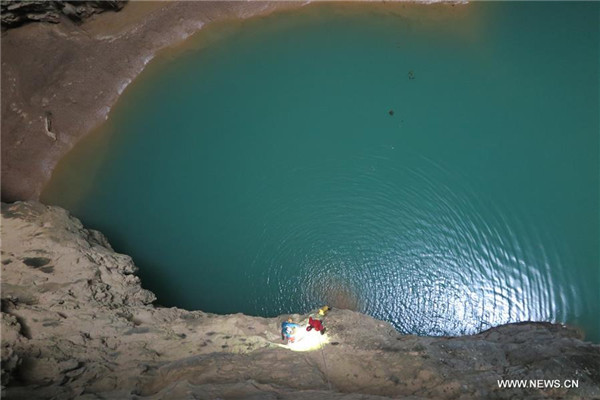China: Giant 420m deep underground sinkhole discovered with waterfalls, lakes and wildlife

Scientists have discovered a giant 420m deep sinkhole in South China. Chinese and French scientists uncovered the sinkhole in the Guangxi Zhuang Autonomous Region of South China.
The giant 420m deep sinkhole was discovered on an eight day expedition, which began on 26 February 2016. This cave stretches 16.5km long and inside there were waterfalls, lakes, rivers and a broad range of stalagmites. Usually, these dolines are around 250m deep. It is rare to find one of this size in China.
The expedition aimed to research 12 of South China's dolines – sinkholes created by repeated cave-ins of underground caves. They investigated sinkholes in Donglan County, Guangxi, reports Xinhua.
The scientists discovered a variety of species living in the sinkholes – which are so big that they appear as giant caves – including bats and snakes. They also found some invertebrates that have not been able to be identified yet.

Other sinkholes
However, the largest sinkhole in the Guangxi region, 'Dashiwei', is 613m deep and 420m wide. It has a forest at the bottom, covering more than 10,000 square metres. In 2003, Dashiwei was opened to the public to create a 'doline museum'.

The world's largest sinkhole is found in the Chongqing Municipality of China, at the top of the Yangtze River. 'Xiaozhai Doline' is 660m deep and has an area of 119 million cubic metres.
Sinkholes, as well as dolines, are usually found in 'karst' areas – a region with a particular type of rock bed.
"A sinkhole in a geological context is a surface depression caused by the subsidence of the ground due to dissolution of a soluble rock [usually limestone, chalk salt or gypsum – ie 'karst' areas] at depth," Andrew Farrant told IBTimes UK.
Sinkholes are common in China, and have been a growing concern – 54 were reported in 2007, 94 in 2008, and 129 in 2009. In August 2012, 99 sinkholes appeared in Beijing in a period of 22 days.
© Copyright IBTimes 2025. All rights reserved.






















